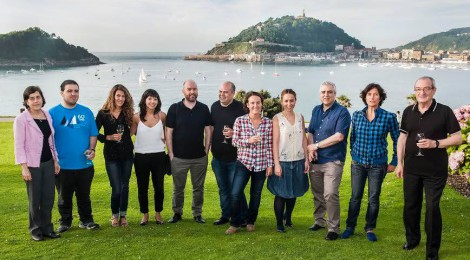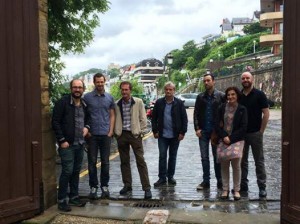
Letter from San Sebastian: Basque Cinema – Three Generations of Filmmakers
Mediático proudly presents a report by our contributing editor Rob Stone on a recent conference on Basque cinema. The conference programme can be downloaded here. Rob Stone is Professor of Film Studies at the University of Birmingham and co-author with María Pilar Rodríguez of Basque Cinema: A Cultural and Political History, forthcoming from I B Tauris in 2015. You can read other Mediático entries by him here.
Letter from San Sebastian: Euskal Zinema: Zinemagileen Hiru Belaunaldi / Cine Vasco: Tres Generaciones de Cineastas / Basque Cinema: Three Generations of Filmmakers
By Rob Stone
The three waves of Basque cinema since the dictatorship swept into San Sebastian for the conference co-organised by the Euskadio Filmategia/ Filmoteca Vasca (Basque Film Institute) and the UPV/EHU (The University of the Basque Country) in the first week of July 2014.
Drawing students, academics, filmmakers, critics and even politicians together, the event at the Palacio Miramar overlooking La Concha (Fig. 1) celebrated the fact that filmmakers from these three generations are all still working and brought them together for an intense three days of discussions. The conference was co-ordinated with great skill, infinite patience and constant good humour by Joxean Fernández (Fig. 2), director of the EF/FV, abetted by Mari Carmen Ausan and others from the Institute. As an accumulating monument to three generations of Basque cinema, the conference marked a point of reflection in the history of the Basque Country that established the importance of its films and filmmakers beyond any internal arguments about its nature or ignorance from elsewhere of its significance and vitality.

Fig. 2: Joxean Fernández, director of Euskadiko Filmategia/Filmoteca Vasca (Basque Film Institute) opens the conference. Photo by Rob Stone.
The first wave is generally considered to be that which followed recognition of the Autonomous Community of Euskadi in 1978, when the new Basque government set about nation-building, in part by generous funding for Basque filmmakers. During the first day of panels and papers this initial wave was essayed by Santos Zunzunegui (UPV/EHU) and Kepa Sojo (UPV/EHU) and ably represented by the key filmmakers (Fig. 3) Ana Díez (Ander eta Yul), Pedro Olea (Akelarre), Imanol Uribe (La muerte de Mikel), and Montxo Armendáriz (Tasio).

Fig. 4: The first wave panel: Santos Zunzunegui, Imanol Uribe, Pedro Olea, Ana Díez and Montxo Armendáriz. Photo by Rob Stone.
Present in spirit only in the rather sombre round table interview and Q&A (Fig. 4) was Victor Erice (El espíritu de la colmena), who had been bumped from his plane up from Madrid that morning at the last moment by Iberia; but his absence only added to his reputation for a reclusive nature. The filmmakers present wore their legacy lightly, particularly the vivacious Díez, and offered polite, nostalgia-flavoured responses to the memory-lane line of questioning steered by Zunzunegui and the reverent queries from the rapt audience.
Day two brought the second wave crashing into San Sebastian. Santiago de Pablo (UPV/EHU) provided an impressive overview of the Basque nation on screen and was followed by Carlos Roldán Larreta (UPV/EHU) giving a detailed account of the works associated with the second wave from the nineties to the present day. They were followed by Casilda de Miguel (UPV/EHU) making the case for ‘lo femenino’ in the history of Basque cinema and a thorough survey of women filmmakers delivered in Euskara by Iratxe Fresneda (UPV/EHU) which revealed all previous histories to be pointedly incomplete. Subsequently, Begoña Vicario examined the condition and status of animation in Basque cinema and Maialen Beloki reflected in Euskara upon her role as programmer of the Basque cinema section of the San Sebastian International Film Festival. Antonio Santamarina of the EF/FV then described the auteurist trajectories of representatives of the second wave before I offered a view of Basque cinema from beyond, one in which arguments over the role of Euskara are a part but not the whole of the argument, by way of a theoretical framework for understanding the development of Basque cinema.
The second wave of Basque cinema that concerned all speakers on the second day is generally associated with a burst of auteurist endeavour in the early nineties from five young male filmmakers who left the Basque Country for Madrid (Fig. 5): Daniel Calparsoro (Salto al vacío), Juanma Bajo Ulloa (Alas de mariposa), Enrique Urbizu (Todo por la pasta), Álex de la Iglesia (El día de la bestia) and Julio Medem (Vacas). This time Medem was absent due to filming commitments in the Canary Islands for Ma Ma starring Penélope Cruz; but his non-attendance suited his reclusive or at least elusive nature too. In his place (and also that of de la Iglesia, who was apparently on his honeymoon) was Helena Taberna (Yoyes) who fits the second generation age-wise but is far removed in terms of trajectory and temperament.
This round-table (Fig. 6) for which there was evident media interest and a capacity audience revealed the importance of testosterone in fuelling the films of the early nineties, but also the rather resentful current obsession with financing exhibited by Bajo Ulloa, Calparsoro and Urbizu. Taberna, meanwhile, offered optimistic interjections and insisted upon her friendly disassociation from the tribulations of the three filmmakers whose banter remained fixated on money problems despite attempts by the chair and members of the audience to steer the discussion elsewhere. Claiming to have ‘trusted the visual aspect of cinema more than the literary one that had previously dominated Spanish cinema’, Bajo Ulloa led the Q&A into a discussion of exactly why this generation of filmmakers had left the Basque Country, although the arguments were not devoid of bitterness and self-justification. ‘We’d reached the public, won prizes, we had technical crew, actors and producers,’ he argued, ‘but all this energy went to Madrid because there was no political foresight to make the best of it. We didn’t want hand-outs, we wanted all this potential to be channelled.’ Calparsoro concurred: ‘We were damned in a way. We didn’t speak Euskara so we had to leave. Maybe they didn’t think we were sufficiently Basque.’
The third day brought a shift in emphasis towards contemporary filmmaking in the Basque Country and the importance of short films in the history and present condition of Basque cinema. Iñaki Lazkano (UPV/EHU) recounted the greatest hits of the Kimuak initiative with which the third wave is commonly associated before a morning round table in which the bonhomie exhibited by these filmmakers replaced the tensions exhibited by Bajo Ulloa and Calparsoro the previous evening. The Kimuak initiative fosters the making of short films in the Basque Country and its representatives tend to move between ‘short’ and ‘long’ films without limitations or prejudice (hence the inverted commas). The recent success of Ocho apellidos vascos, which was scripted by Borja Cobeaga featured in a lively discussion led by Txema Muñoz and featuring (Fig. 7) Jose Mari Goenaga (80 egunean), Pablo Malo (Jardines deshabitados), Aiser Altuna (Aupa Etxebeste!) Koldo Almandoz (Ahate Pasa) and Isabel Herguera (Bajo la almohada).
Money problems were certainly referenced in this panel (Fig. 8) but not allowed to dominate. By way of contrast, Cobeaga provoked hilarity and applause when he professed to have left the Basque Country for Madrid ‘because I like going into to a bar and having the waiters be nice to me.’ He recalled the impact of the films of the second wave on the third and admitted that he and his peers had ‘yet to “kill the father”’ in terms of a generation-defining feature, though he allowed that this could just as easily be a ‘short’ as a ‘long’ film. Goenaga recounted the production history of 80 egunean and admitted that EiTB (Basque Television) ‘give you more money if you make the film in Euskara.’ Perhaps the most accomplished of those in the panel, Altuna spoke eloquently about why ‘the traditional production system is out of date’ but discounted new methods of financing such as crowdfunding, which he described as ‘like begging.’
Drawing to a close, the conference offered an interesting panel discussion with representatives of the Basque film industry and a round table of regional film critics from Basque newspapers, some of whom appeared to have shirked their major responsibility in favour of minor celebrity. Other notable papers included Susana Torrado (Universidad de Murcia) surveying academic writing on Basque cinema by Basque academics and María Pilar Rodríguez (Deusto) calling the attention of the conference to other examples of Basque cinema such as the films and documentaries made by the Basque diaspora. Andoni Elezcano (UPV/EHU) described the elliptical history of the film Sinfonía vasca, a copy of which he has only recently discovered, and Josu Martínez offered a similar account of the ‘lost’ film Gure sor lekua.
In sum, this three day conference on three generations of Basque filmmakers marked the territory of Basque cinema as one that is both thriving and frustrated. Vitality in academic writing, the activities of the EF/FV and the making of short films is evident and heartening. But financial limitations, the lack of support from the Spanish government for filmmakers and audiences, and complicated new forms of production and distribution are all threats to ingenuity and collaboration. Nevertheless, this was an event marked by optimism, of marking the start of something rather than its end, and of there being clear potential for continuity. A book of proceedings that includes revised versions of the papers and transcriptions of the various round tables and panels is currently in production and will be published by the EF/FV before the end of the year.
[Figs 3, 5 & 7 and the featured image for this entry are by Juantxo Egaña and appeared at the Filmoteca Vasca Facebook page during the conference)












